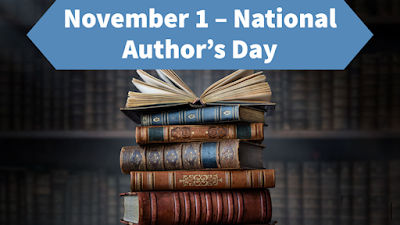A Tribute to the Storytellers Who Shape Our World
📚 What Is National Authors’ Day?
Every year on November 1st, the United States observes National Authors’ Day, a day to honor and celebrate writers—those who capture human experience through novels, poetry, non-fiction, and all written forms of expression.
Whether you're a fan of thrilling fiction, moving memoirs, children’s stories, or academic works, this day is your chance to say “thank you” to the authors whose words have changed your life.
🖋️ Origin of the Day
National Authors’ Day was established in 1928 by Nellie Verne Burt McPherson, president of the Illinois Women’s Club Federation. After writing a letter of appreciation to author Irvin S. Cobb, she decided that all authors deserved such recognition. In 1949, the U.S. Department of Commerce officially recognized November 1st as National Authors’ Day.
📖 Why It Matters
Authors are time travelers, culture carriers, and mind-openers. They:
-
Ignite imagination
-
Share knowledge
-
Preserve history
-
Inspire change
They spend countless hours researching, editing, and dreaming so that we can feel more connected, understand more deeply, and escape more beautifully.
💬 How to Celebrate
-
Thank an author: Leave a heartfelt comment or message on their website or social media.
-
Buy a book: Support indie and local authors by purchasing their work.
-
Write a review: Share your love for a book online to help others discover it.
-
Start writing: If you have a story inside you—this is the perfect day to begin.
-
Visit a library or bookstore to discover new voices.
🧠 Did You Know?
-
The average author spends months or years crafting one book.
-
Self-publishing has allowed thousands of new voices to reach readers worldwide.
-
November 1st also kicks off NaNoWriMo (National Novel Writing Month), a challenge to write a 50,000-word novel in 30 days.
🧑🎨 Artistic Tribute by CRA ARTS
As an artist, you can honor authors through:
🎨 Illustrated Quotes: Paint or draw powerful quotes that shaped your life.
📚 Portraits of Great Authors: From Shakespeare to Maya Angelou, honor the faces behind the words.
🌍 Symbolic Art: Show how books create bridges between cultures, ideas, and generations.
Imagine a painting of a tree growing from an open book, each branch representing a genre—mystery, love, wisdom, courage.
✨ Featured Quote for the Day
“A writer only begins a book. A reader finishes it.”
— Samuel Johnson
📌 Related Observances
-
World Book Day – 23 April
-
National Poetry Month – April (U.S.)
-
International Literacy Day – 8 September
-
Read Across America Day – March 2
📖 For more reflections on creativity, literature, and art, visit:
👉 CRA ARTS Blog – https://craarts.blogspot.com

Comments
Post a Comment